
Centaurea is a genus of over 700 species of herbaceous thistle-like flowering plants in the family Asteraceae. Members of the genus are found only north of the equator, mostly in the Eastern Hemisphere; the Middle East and surrounding regions are particularly species-rich. In the western United States, yellow starthistles are an invasive species. Around the year 1850, seeds from the plant had arrived to the state of California. It is believed that those seeds came from South America.
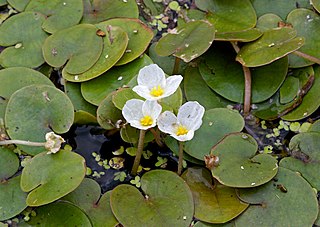
Hydrocharis is a genus of aquatic plants in the family Hydrocharitaceae described as a genus by Carl Linnaeus in 1753. It is widespread across much of Europe and Asia, plus a few scattered locations in Africa. It is also reportedly naturalized in parts of North America.

Cardamine hirsuta, commonly called hairy bittercress, is an annual or biennial species of plant in the family Brassicaceae, and is edible as a salad green. It is common in moist areas around the world.

Eriogonum fasciculatum is a species of wild buckwheat known by the common names California buckwheat and flat-topped buckwheat. Characterized by small, white and pink flower clusters that give off a cottony effect, this species grows variably from a patchy mat to a wide shrub, with the flowers turning a rusty color after blooming. This plant is of great benefit across its various habitats, providing an important food resource for a diversity of insect and mammal species. It also provides numerous ecosystem services for humans, including erosion control, post-fire mitigation, increases in crop yields when planted in hedgerows, and high habitat restoration value.
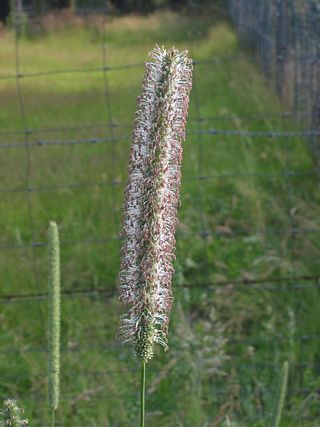
Phleum (timothy) is a genus of annual and perennial plants in the grass family. The genus is native to Europe, Asia and north Africa, with one species also in North and South America.

Centaurea cineraria, the velvet centaurea, is also known as dusty miller and silver dust. Centaurea cineraria is in the family Asteraceae and is endemic to Italy. In natural settings, it grows on coastal cliffs, ranging from 0–350 m above sea level. Mature plants may reach 80 centimetres (31.5 in) in height. Centaurea cineraria produces purple flowers.

Polystichum acrostichoides, commonly denominated Christmas fern, is a perennial, evergreen fern native to eastern North America, from Nova Scotia west to Minnesota and south to Florida and eastern Texas. It is one of the most common ferns in eastern North America, being found in moist and shady habitats in woodlands, stream banks and rocky slopes. The common name derives from the evergreen fronds, which are often still green at Christmas.

Platanthera blephariglottis, commonly known as the white fringed orchid or white-fringed orchis, is a species of orchid of the genus Platanthera. It is considered to be an endangered species in Connecticut and Ohio, a threatened species in Florida, Maryland and Rhode Island, exploitably vulnerable in New York, and susceptible to be threatened in Québec.

Centaurea jacea, brown knapweed or brownray knapweed, is a species of herbaceous perennial plants in the genus Centaurea native to dry meadows and open woodland throughout Europe. It grows to 10–80 centimetres (4–31 in) tall, and flowers mainly from June to September.

Psephellus dealbatus, the Persian cornflower or whitewash cornflower, is a species of Psephellus native to the Caucasus Mountains and Turkey. It is widely cultivated as an ornamental perennial.
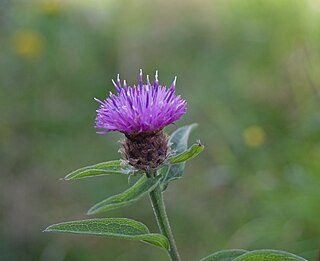
Centaurea nigra is a species of flowering plant in the family Asteraceae known by the common names lesser knapweed, common knapweed and black knapweed. A local vernacular name is hardheads.

Amberboa is a genus of flowering plants in the family Asteraceae, described as a genus in 1832.
Chaetorellia succinea is a species of tephritid fruit fly that was accidentally released in 1991 into the United States and had since become one of the major biological pest controls against the noxious weed yellow starthistle.

Sagittaria platyphylla, the delta arrowhead, broad-leaf arrowhead or delta duck-potato, is a plant species native to the eastern United States. The core of its range extends from central Texas to the Florida Panhandle north to southern Illinois.

Limnobium, common names spongeplant and American frogbit, is a group of aquatic plants in the Hydrocharitaceae described as a genus in 1814. It is widespread in freshwater environments in Latin America, the West Indies, and the United States.

Centaurea macrocephala is a species of flowering plant in the family Asteraceae, and a member of the thistle tribe, Cynareae. It has many common names, including bighead knapweed, big yellow centaurea, lemon fluff, yellow bachelor's button, yellow hardhat, and Armenian basketflower.
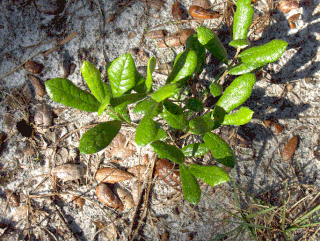
Quercus pumila, the runner oak or running oak, is a species of oak. It is native to the southeastern United States.

Hypericum lancasteri, known as Lancaster's St. John's wort or as zhan e jin si tao in Chinese, is a species of flowering plant in the St. John's wort family Hypericaceae. The species has been awarded the Royal Horticultural Society's Award of Garden Merit.
Erysimum deflexum, the bent treacle mustard, is a herbaceous plant, a member of the family Brassicaceae.
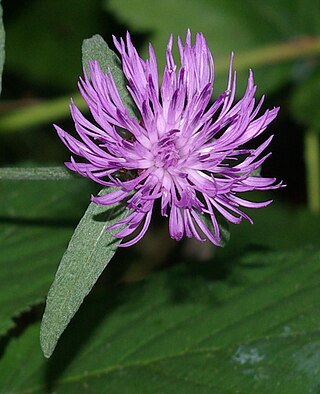
Meadow knapweed is a fertile hybrid between black knapweed and brown knapweed. It is also known by the common names of hybrid knapweed or protean knapweed. The taxonomic status of the species is uncertain, and meadow knapweed has been variously described as different species. The Flora of North America refers to meadow knapweed as the nothospecies Centaurea × moncktonii.


















